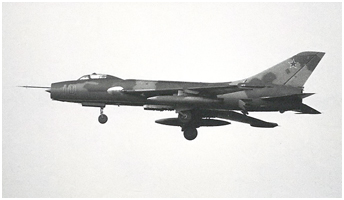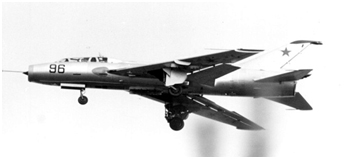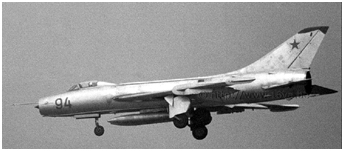Remarks
The Soviet scenario is particularly dangerous and almost suicidal. It assumes that the battery(ies) did not reposition based on a possible conflict looming on the horizon. Indeed, many rehearsals took place using a mission preparation model (for example) where the obstacles and the configuration of the terrain interfering with the flights would be presented and studied at length. Moving the batteries to another location would completely upset the mission.
 The preparation and the preliminary harassment are very much in the Soviet way op operation and reflect the doctrine of employment of their material as experienced
in the Middle East. This also reveals their thinking. They estimate that the "Hawkists" will react just like Soviet troops would. Hawk firing officers
(TCO - Tactical Control Officer), must be able to "sniff out" trouble despite the automatic systems. In modern weapon systems where, tactical decisions are
"suggested" by a computer, this "human" capability is arguably depreciated.
The weakness of the Hawks, i.e., "one aircraft per fire control radar" was common to all systems in the world since the SCR-584 back in 1943! Raytheon Hawks with two firing
radars per battery thus offered a parade undoubtedly insufficient but superior to any other means of air defense then in service. It only was with the PIP-III modifications
and the advent of sufficiently miniaturized computers (signal processing) for the IHPIR (Improved High Power Illumination Radar) radars that they were able to track and fire
on six targets (1) simultaneously, the LASHE (Low-Altitude Simultaneous Hawk Engagement) mode.
Note that the Nikes had solved the problem of saturation attacks by arming the Nike-Hercules with a nuclear charge. This notion had remained relevant with the Hawks,
at least in the boxes! We remember that the BCC (Battery Control Center) delivered by SETEL in Europe had an MBA (Minimum Burst Altitude) setting
never described in the manuals and which was removed around 1970 during a technical update.
The preparation and the preliminary harassment are very much in the Soviet way op operation and reflect the doctrine of employment of their material as experienced
in the Middle East. This also reveals their thinking. They estimate that the "Hawkists" will react just like Soviet troops would. Hawk firing officers
(TCO - Tactical Control Officer), must be able to "sniff out" trouble despite the automatic systems. In modern weapon systems where, tactical decisions are
"suggested" by a computer, this "human" capability is arguably depreciated.
The weakness of the Hawks, i.e., "one aircraft per fire control radar" was common to all systems in the world since the SCR-584 back in 1943! Raytheon Hawks with two firing
radars per battery thus offered a parade undoubtedly insufficient but superior to any other means of air defense then in service. It only was with the PIP-III modifications
and the advent of sufficiently miniaturized computers (signal processing) for the IHPIR (Improved High Power Illumination Radar) radars that they were able to track and fire
on six targets (1) simultaneously, the LASHE (Low-Altitude Simultaneous Hawk Engagement) mode.
Note that the Nikes had solved the problem of saturation attacks by arming the Nike-Hercules with a nuclear charge. This notion had remained relevant with the Hawks,
at least in the boxes! We remember that the BCC (Battery Control Center) delivered by SETEL in Europe had an MBA (Minimum Burst Altitude) setting
never described in the manuals and which was removed around 1970 during a technical update.
The real weakness of the circa-1960 Hawks was undoubtedly their relative impotence when changing position. In operation, the isolated Hawk battery moved in two stages.
The AFU (Assault Fire Unit, assault section) with the CWAR low- and medium-altitude radar, an illuminator radar, and two launchers would take position on the future site of the battery.
The section would provide aerial security for the bulk of the battery during its redeployment. The efficiency of the battery on its original site, without low altitude coverage, would
then be very significantly reduced. As for the AFU, which lacks a remote lookout, without ADL or IFF - as the unimproved Hawk systems were in 1970 -
and in the previous Soviet hypothesis, we are entitled to be pessimistic.
The description of the attack makes no mention of electronic countermeasures (EM, ECM, ECCM) where the Hawk was (it seems) scoring points on their Soviet adversaries.
In this respect, we know that their use on one side or the other would reveal their capacities, this almost being the equivalent of a single-shot rifle.
But in this case the immediate goal was to pass at all costs!
Finally, this plan shows that the Soviets had a very high opinion of the Hawk weapon system.
The French experience
 Three former Hawk battery commanders of the model we're concerned about (before the Improved HAWK) think that the Russian assault is suicidal.
But one of the battery commanders who served on the "barrier," although patented TCO of the ADA (Air Defense Artillery) of Fort Bliss, does not remember having studied this nuclear attack
configuration. Two senior Hawk officers were aware of this and agree. One of them who commanded a Hawk regiment writes: "Basically, nothing new: I had already studied this Soviet saturation
attack procedure at the school of Nīmes (around 1964). Fortunately in 1983-85, during my command - he was then a Colonel - the improved Hawk made it possible to face it."
Another Hawk Corps Commander and ADA gunnery officer writes: "I think that this attack would not have been a total surprise for the NATO command; there would have been tension before it and
the Hawk units, in particular, would have been put on alert in centralized fire, but without excluding local initiatives." He adds: "The units are in mutual assistance and the firing capabilities
are optimized by the choice of battery locations, which can allow two or even three missiles to be fired on a detected aircraft route".
Three former Hawk battery commanders of the model we're concerned about (before the Improved HAWK) think that the Russian assault is suicidal.
But one of the battery commanders who served on the "barrier," although patented TCO of the ADA (Air Defense Artillery) of Fort Bliss, does not remember having studied this nuclear attack
configuration. Two senior Hawk officers were aware of this and agree. One of them who commanded a Hawk regiment writes: "Basically, nothing new: I had already studied this Soviet saturation
attack procedure at the school of Nīmes (around 1964). Fortunately in 1983-85, during my command - he was then a Colonel - the improved Hawk made it possible to face it."
Another Hawk Corps Commander and ADA gunnery officer writes: "I think that this attack would not have been a total surprise for the NATO command; there would have been tension before it and
the Hawk units, in particular, would have been put on alert in centralized fire, but without excluding local initiatives." He adds: "The units are in mutual assistance and the firing capabilities
are optimized by the choice of battery locations, which can allow two or even three missiles to be fired on a detected aircraft route".
Instruction: Simulation and exercises with aircrew
 Two simulators, initially the AN/TPQ 21 and later the AN/TPQ 29 (for the Improved Hawk modification) made it possible to simulate the Soviet maneuver in all its details.
A major difference between the two simulators was the capability to program the entire sequence without having to manually "steer" any of the objectives and obtain more rigor in the
evaluation of the personnel tested. It also made it possible to program all sorts of scenarios, to store them in memory, and therefore to replay them. The Soviet nuclear attack scenario
was one among many that faced the armies of all countries that could be confronted with this type of situation.
Two simulators, initially the AN/TPQ 21 and later the AN/TPQ 29 (for the Improved Hawk modification) made it possible to simulate the Soviet maneuver in all its details.
A major difference between the two simulators was the capability to program the entire sequence without having to manually "steer" any of the objectives and obtain more rigor in the
evaluation of the personnel tested. It also made it possible to program all sorts of scenarios, to store them in memory, and therefore to replay them. The Soviet nuclear attack scenario
was one among many that faced the armies of all countries that could be confronted with this type of situation.
Commander Picard (ER) who was a simulation "programmer" in Nīmes, Hawk instructor, and evaluator of the Crotale system for the Army writes:
"I have indeed taken part in several exercises in the context of air defence, with the airmen as well as with the sailors of the naval aviation, working on the difficulties encountered in intervening
on one or more missile batteries as an attacker or a defender. During course 6140 "Hawk Officer" in 1967 at the ESAA (School of Specialization in Anti-Aircraft Artillery) one of the themes was: 'Air resources
to be used to saturate an anti-aircraft defense system.'
To solve the problem, you had to take into account a large number of factors, but in the end, it was not very difficult. Using the simulator, it was possible to check the solutions proposed by the
trainees or the results of the theoretical problems posed in class. Still with the simulators, we had also studied the possibility of responses from the Hawk to ballistic missile attacks."
The principle of the feint of the two planes attacking simultaneously is not new for fighters and dates from long before the missile batteries. This case was also studied in simulation
and in real life. In particular, it was observed with the HPIR of the time that the close position of two aircraft in the reception cone of the radar could disturb the discriminating power of
the antenna and make it oscillate from one target to another, which was quite annoying.
Note that the second HPIR could participate in the pursuit and, moreover, on a different tracking frequency if ever the target used electronic countermeasures.
Conclusion
It is tempting to say that the air defense of the "Barrier" was, in 1970, ready and able to repel the invader. Others, in other times, sincerely thought that there was not a single button missing from the suspenders at their expense! We know the rest. But we will never know, fortunately, if the Hawks were really "the best in the world."
© G.Dessornes
Acknowledgements: This document has been reviewed, critiqued and expanded by my comrades and "Hawk" friends who were kind enough to put their helmets back on and share their experience. Thank you, in particular, to Sirs Abrell (Col.Er), Balliot (Col.Er), Frémont (CE.Er), Picard (CE.Er), Marey (CE.Er) and Scavardo (Lt-Col. Er).
notes
(1) The latest IHPIR Hawk version handles up to 12 targets. A calculator assists the TCO in the choice of threats.
 |
Hawk strike: analysis < Part 1 |
 |
Plan du site - Sitemap |  |
